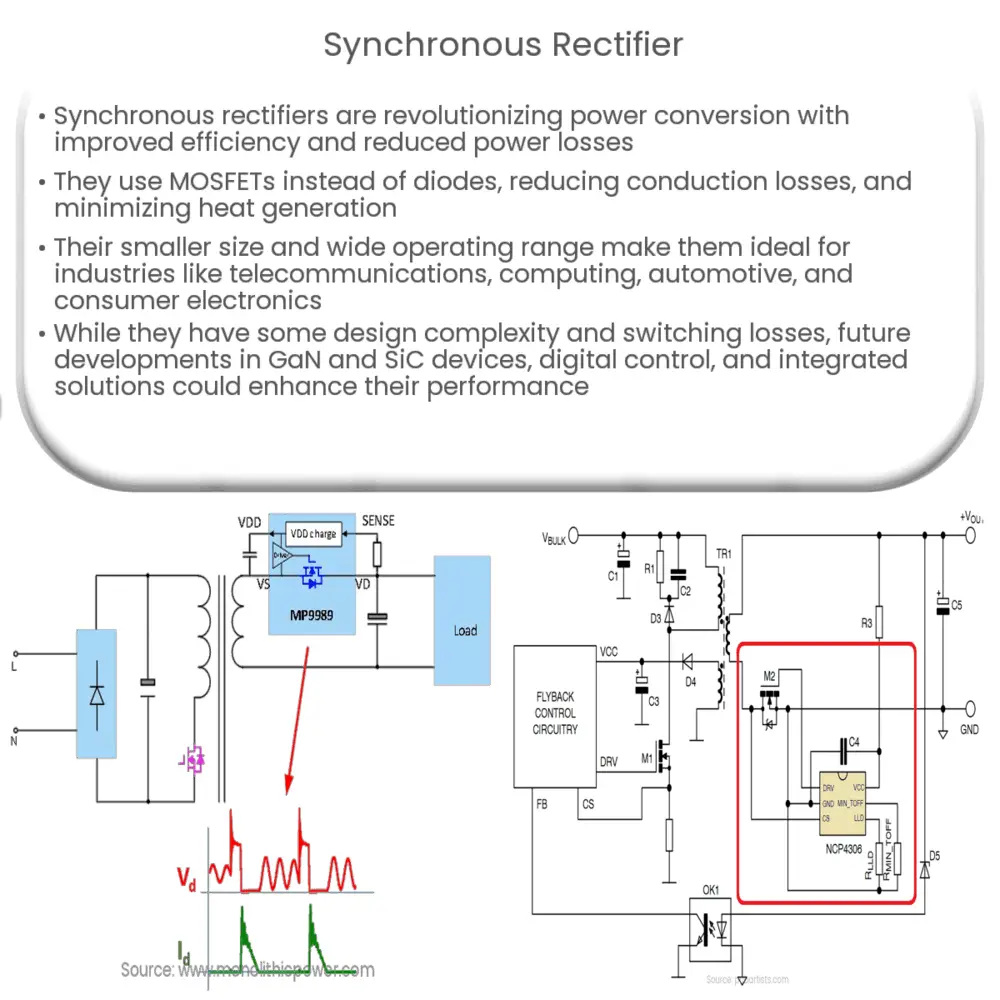Synchronous rectifiers are power conversion components that use low-resistance MOSFETs, offering enhanced efficiency and reduced heat generation.

Synchronous Rectifiers: A Revolution in Power Conversion Efficiency
Introduction
Over the years, the demand for higher energy efficiency and miniaturization in electronic devices has grown exponentially, driving the need for improved power conversion technologies. Synchronous rectifiers are a vital development in this quest, as they promise increased efficiency and reduced power losses in switched-mode power supplies (SMPS). In this article, we will explore the fundamentals of synchronous rectification, its advantages over traditional rectifiers, and its applications in various industries.
What is Synchronous Rectification?
Synchronous rectification is a method of power conversion where low resistance MOSFETs (Metal-Oxide-Semiconductor Field-Effect Transistors) are used as rectifying elements instead of traditional diodes. These MOSFETs are driven synchronously with the switching frequency of the power supply, ensuring seamless power conversion with minimal losses.
While conventional rectifiers rely on diodes, which have an inherent forward voltage drop, synchronous rectifiers leverage the low on-state resistance (Rds(on)) of MOSFETs. This results in reduced conduction losses and improved efficiency, especially in low voltage, high current applications.
Benefits of Synchronous Rectifiers
There are several advantages to using synchronous rectifiers over traditional rectifiers, including:
- Improved Efficiency: Due to their low Rds(on), MOSFETs used in synchronous rectifiers have reduced conduction losses as compared to diodes, leading to higher efficiency in the power conversion process.
- Reduced Heat Generation: By minimizing power losses, synchronous rectifiers produce less heat, enabling better thermal management and improving the reliability of electronic devices.
- Smaller Component Size: As synchronous rectifiers require fewer passive components to maintain the same level of efficiency, the overall size of the power supply can be reduced, allowing for greater miniaturization of electronic devices.
- Wide Operating Range: Synchronous rectifiers can operate effectively over a broad range of input voltages and output currents, making them suitable for various applications.
Applications of Synchronous Rectifiers
Given their enhanced efficiency and versatility, synchronous rectifiers have found applications across a wide array of industries. Some of the key areas where they are employed include:
- Telecommunications: Synchronous rectifiers are used in DC-DC converters, which provide power to network equipment, including routers, switches, and base stations.
- Computing: High-performance processors and memory modules require efficient power management, which can be achieved using synchronous rectifiers in voltage regulators and power supplies.
- Automotive: Electric and hybrid vehicles demand highly efficient power conversion systems, and synchronous rectifiers play a crucial role in battery charging and energy management subsystems.
- Consumer Electronics: In devices such as smartphones, laptops, and smart TVs, synchronous rectifiers improve power supply efficiency, enabling longer battery life and better performance.
Design Considerations for Synchronous Rectifiers
While synchronous rectifiers offer numerous advantages, their implementation requires careful consideration of several design factors:
- Control Method: Synchronous rectifiers can be controlled using either self-driven or externally-driven methods. Self-driven control relies on the voltage waveform across the rectifying element, while externally-driven control uses an additional control signal. The choice between these methods depends on factors such as complexity, cost, and performance requirements.
- Dead Time: To avoid cross-conduction, a brief period of dead time is required when both the high-side and low-side MOSFETs are off. Proper dead time management is crucial to prevent shoot-through currents and ensure efficient operation.
- Parasitic Inductance: High di/dt currents in synchronous rectifiers can result in voltage spikes due to parasitic inductance. Careful PCB layout and component placement can help minimize these effects and improve overall efficiency.
- MOSFET Selection: Choosing the right MOSFET for a synchronous rectifier is vital to achieve optimal performance. Key parameters to consider include Rds(on), gate charge, voltage rating, and thermal performance.
Challenges and Future Developments
Despite their numerous benefits, synchronous rectifiers also face some challenges:
- Complexity: The control circuits for synchronous rectifiers can be more complex than those for traditional rectifiers, increasing design time and costs.
- Switching Losses: While conduction losses are significantly reduced in synchronous rectifiers, switching losses may still be a concern, especially at higher frequencies.
As technology continues to advance, researchers and engineers are working to address these challenges and further improve the performance of synchronous rectifiers. Some promising areas of development include:
- GaN and SiC Devices: Wide-bandgap semiconductors such as gallium nitride (GaN) and silicon carbide (SiC) offer lower Rds(on), faster switching speeds, and higher thermal performance than traditional silicon MOSFETs, making them an ideal choice for synchronous rectifiers in high-performance applications.
- Digital Control: The use of digital control techniques can improve the performance and adaptability of synchronous rectifiers, enabling them to better cope with varying load conditions and input voltages.
- Integrated Solutions: As the demand for smaller and more efficient power supplies continues to grow, integrated synchronous rectifier solutions are becoming increasingly popular. These solutions combine the control circuitry and MOSFETs into a single package, reducing component count and simplifying the design process.
Conclusion
Synchronous rectifiers have revolutionized power conversion efficiency by reducing conduction losses and enabling more compact and thermally efficient designs. Their widespread adoption across various industries demonstrates their effectiveness in meeting the growing demands for energy efficiency and miniaturization. By addressing the existing challenges and capitalizing on future developments, synchronous rectifiers will continue to play a crucial role in shaping the future of power electronics.

